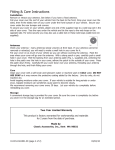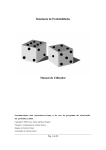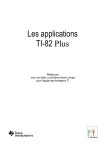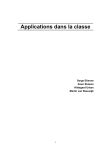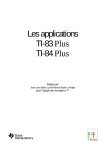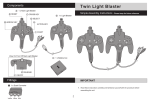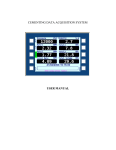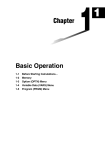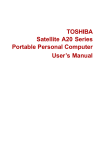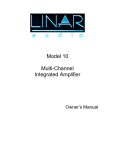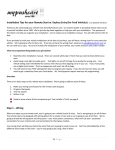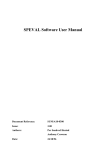Download Probability Simulation User`s Manual
Transcript
Probability Simulation User’s Manual Documentation of features and usage for Probability Simulation Copyright 2000 Corey Taylor and Rusty Wagner 1 Table of Contents 1. General Setup 3 2. Coin Section 4 3. Dice Section 5 4. Marbles Section 6 5. Spinner Section 7 6. Cards Section 7 7. Random Number Section 8 8. Advanced Options 9 2 1. General Setup 1.1 Installation Probability Simulation is a FLASH application for the TI-83 Plus calculator and is not installed in the same way as a regular program. To install this application, the file ProbSim.hex must be placed in the FLASH (or Archive) memory of your calculator. This can be easily done with the TI-Graph Link Software for the TI-83 Plus calculator. After the program is open, make sure the correct PORT (Com 1/2/3/4) is selected under the Link menu. Also, make sure the correct cable type is selected under the Link menu. Once that is done, connect the cable to the calculator and turn the calculator on. The final step is to go to the Link menu, select the Send Applications option and use that screen to send to the calculator. If errors occur, make sure the link is correctly in place and the COM port is the right one. If all else fails, and you are using the Black link, take off the extra connection that came with it and hook up the Calc-to-Calc cable. This could help if the other cable is defective and will make the connection longer. Once the application is correctly installed, you can find the program by hitting the blue APPS button on the calculator. TI provides documentation and help for the installation program through the help menu or by contacting TI directly. The Texas Instruments web site is http://www.ti.com/calc/. 1.2 Identifying Sections When you open the application, there should be a vertical selection list of 6 trial mediums: Toss Coins, Roll Dice, Pick Marbles, Spin Spinner, Draw Cards and Random Numbers. These are the types of trials that can be performed. There is, however, a lot more that can be done with these trials than simple simulation, there could be multiple objects and settings along with these sections. The only non-sectional specific setting in the application is the random number seed setting. This can be used in order to make the trials statistically correct and the same on multiple calculators. Going to the OPTN menu using the F3 key on the calculator can set this to the desired number. 1.2.1 Toss Coins This section is used for simulation of a two-sided probability but these sides can be weighed. Up to 3 coins can be flipped at once and the number of heads is counted for anything over 1 coin. 2.1.2 Roll Dice This section is used for simulation of items that have multiple outcomes for each piece. The type of dice includes 6,8,10,12 and 20 sided dice. Up to 3 dice can be rolled at once and the value total is counted 2.1.3 Pick Marbles 3 This section is used for simulation of many types of objects along with large numbers in each section. There are 5 types of marbles with the number of each variable as per user settings. The number of each type picked is counted. 2.1.4 Spin Spinner This section is used for simple simulation of a multi-sided object. There can be between 2 and 8 sides to the spinner but only one spinner can be used. The probability of each section can be weighed and the section selection is counted. 2.1.5 Draw Cards This section is used for a large number of objects along with different categories with equal numbers in them. There is a 52 and 32 card deck option. Each card is shown in a table along with number and suit. Only one deck can be used at a time. 2.1.6 Random Numbers This section is used for a straightforward example of random numbers. It is done in the same manner of a slot machine with up to 6 numbers be randomized at once. These numbers can be from 0 to 99 and each set of trials is shown. 2. Coin Section 2.1 Setting up the simulation From the coin section main screen, select the “SET” menu item by pressing F3. This will take you to the Settings screen. 2.1.2 Trial Set This is set to 1 by default. When set at one, 1 trial will occur when you press “TOSS” and then a menu will appear with further trial amounts of 1, 10 and 50. If you edit this number to be anything other than 1, that amount of trials will occur when you press “TOSS” but no menu will appear after that. 2.1.3 Coins This is set to 1 by default. The Coins is the number of coins flipped per trial. You can set it from 1 to 3 only. If there is more than one coin, the total number of heads will be counted. 2.1.3 Graph This is set to frequency (Freq) by default. When frequency is selected, the graph-selection text will display the frequency or number of times the heads have occurred. When simulated probability (SimProb) is selected, the graph-selection text will display the relative ratio that has occurred for that coin. 2.1.4 StoTbl This has three settings with All as the default. When set to No, only the graph can be viewed and no table data can be seen. The only other viewable amount is 50, other than all. 4 2.1.5 ClearTabl Set this to Yes if you want the data to be cleared. This is automatically set when certain other settings are changed. 2.1.6 Updates You can choose how many trials you want to occur before the graph and data are updated. Updates for every trial is the default and only 20, 50 and the end are available. 3 2.2 Use of the section After the settings are adjusted, the next step is to either select the data view screen or start the trials. If you want to view the actual data of the trials, make sure you are in the DATA section. The GRPH section will show updated graphs of the trial data. When you are finished with the trials, you can go to the GRPH section and use the left/right arrow keys to select the columns. According to the setting data, either the frequency or ratio information will be shown above the graph. The selected column can be identified by a shading effect. 2.3 Exporting data lists By using the data screen, the user can export data from a simulation into lists on the calculator to enable further exploration of the data. The data screen shows which lists the data will be exported into, but is not editable. In this section, the ‘TOSS’list will contain the toss number, ‘C1’, ‘C2’, and ‘C3’contain the results for each coin (0 for tails and 1 for heads), and ‘TOT’contains the total number of heads for each trial. If there was only one coin used in the simulation, the ‘TOT’list is replaced by ‘CUM’, which holds the cumulative number of heads up to that specific trial. Dice Section 3.1 Setting up the simulation This section has basically the same settings as the coin section. The only main difference is the Sides setting. This can be 6, 8, 10, 12, or 20, and defines how many sides each dice will have. Corresponding types of dice are used in the animation for each of those available. See SECTION 2. 3.2 Use of the section This section is used almost the exact same way as the coin section. The main exception to this is that the total sum of the rolled dice is counted when multiple dice are used. The graph and data usage is the same, along with how to perform the trials. When a multi-sided dice is used where there are too many possible totals to fit on one screen, arrows will appear to inform you that more graph bars exist than can be seen. By using the arrow keys at the edges of the visible part of the graph, you can scroll to the other bars. 5 3.3 4 Exporting data lists The data screen allows the user to export the trial data into lists. In this section, the ‘ROLL’list will contain the trial number, ‘D1’, ‘D2’, and ‘D3’contain the results for each die, and ‘SUM’contains the sum of the numbers on each die. Marbles Section 4.1 Setting up the simulation This section has basically the same settings as the dice section. The only main difference is the Marble Types setting. This can be 2, 3, 4 or 5, and defines the number of separate types of marbles there will be. Corresponding types of marbles are used in the animation for each of those available. See SECTION 3. 4.1.2 Replace When this is set to yes, each tile is replaced after it is drawn and counted. If this is set to no, the marble is removed when it is drawn. 4.2 Use of the section Before you start the trials, there are a few things to note about this section. First, if you have replace set to yes, there will be an “R” in the upper-left hand side of the screen. Plus, since you are putting the marbles back into the pot, you will not run out of marbles to choose. The marbles will eventually run out if you do not replace them. In this case, a message will appear after all the marbles have been depleted. Second, expect the animation to be slightly different depending on the replace setting. In order to perform more trials, you will have to either clear the data, or set the replace setting to yes. This will in turn clear the data. 4.1.2 Exporting data lists The data screen allows the user to export the trial data into lists. In this section, the ‘ROLL’list will contain the trial number, ‘D1’, ‘D2’, and ‘D3’contain the results for each die, and ‘SUM’ contains the sum of the numbers on each die. 4.3 Exporting data lists The data screen allows the user to export the trial data into lists. In this section, the ‘PICK’list will contain the trial number. The ‘A’, ‘B’, ‘C”, ‘D’, and ‘E’lists represent which marble was drawn for each trial. The list representing the marble that was drawn will have a 1 stored for that trial and all others will have a 0 stored. 6 5.0 6. Spinner Section 5.1 Setting up the simulation This section has basically the same settings as the coin section. The only main difference is the Sections setting. This can be typed in as between 2 and 8. This creates more sections in the spinner area plus creates more areas for weights to be placed on. A spinner will spin over the allotted sections and the arrow will stop over the final section. For visual clarity, the spinner will NOT end on a separation line in this simulation. See SECTION 2. 5.2 Use of the section This is a bit different section than the others in use. There is only ONE spinner, but there can be different numbers of sections and each section can be weighed. The section size will correspond with the weight on that section. While the spinner is spinning, there will be a number on the upper right hand side displaying the number that the spinner is currently over. This will show the number clearly even when some sections are too small to see clearly. 5.3 Exporting data lists The data screen allows the user to export the trial data into lists. In this section, the ‘SPIN’list will contain the trial number. The ‘SECT’list will hold the number of the section on which the spinner stopped for each trial. Cards Section 6.1 Setting up the simulation There are relatively few settings for this section. You are limited to drawing one card at a time but the decks can be changed. 6.1.1 Decks This is set at 1 for default. You can have 1, 2 or 3 decks. This means that for multiple decks, more than one copy of a card will exist to choose. 6.1.2 Replace When this is set to yes, each card is replaced after it is drawn and counted. If this is set to no, the card is removed when it is drawn. 6.1.3 Deck Size This setting is here to allow for use of a European style deck of 32 cards. (There are no special suits for the 32-card deck.) The other deck available is 52 and is the default. 6.2 Use of the section Since this section has a replace option like the marbles section, an “R” will appear in the upper left hand corner when replace is turned on. Of course, having replace turned off would mean that you could run out of cards. In 7 this case, a message will appear when you have run out of cards. You will have to reset the data or set the replace option to yes before you can do more trials. 6.3 7. Exporting data lists The data screen allows the user to export the trial data into lists. In this section, the ‘DRAW’list will contain the trial number. The ‘VALUE’list will hold the number on the card that was drawn for each trial. Ace is represented with a 1, jack with an 11, queen with a 12, and king with a 13. The ‘SUIT’list will hold the suit of the card that was drawn. Hearts are represented with a 1, clubs with a 2, spades with a 3, and diamonds with a 4. Random Number Section 7.1 Setting up the simulation This is a really simple section to setup. Since the simulation is just a row of random numbers, there are only a few options that can be changed. 7.1.1 Numbers This setting determines how many random numbers are drawn per trial. There can be between 1 and 6 numbers only. 7.1.2 Range This range is the numbers, which can be chosen during the trial. The same range is set for each of the separate numbers that are drawn. You can set the minimum and the maximum from 0 to 99. 7.1.3 Replace This setting simply allows the numbers to be reused after they have been chosen in a trial. If replace is not turned on, each trial will be unique. 7.2 Use of the section This section does not have much special use other than single trials of random number drawing. The number chosen for each is shown in the list but no special graph or statistical data is shown on the screen. This is raw generation of random numbers for your use and disposal. 7.3 Exporting data lists The data screen allows the user to export the trial data into lists. In this section, the ‘DRAW’list will contain the trial number. The ‘N1’-‘N2’ lists will hold the numbers that were generated for each trail. If more than one number is being generated at once, the ‘TOT’list will hold the sum of all the numbers for each trail. If there is only one number being generated at a time, the ‘CUM’list will hold the cumulative sum of the numbers up to that specific trial. 8 8. Advanced Options The advanced options section allows you to change the probabilities for each outcome. This could be used to simulate unfair dice and weighted coins, for example. The advanced options section can be reached by pressing the ‘ADV’ key in the options screen for the coin, dice, marbles, and spinner sections. 8.1 Weights The left column in the advanced options screen represents the relative weight of each outcome. The weight for an outcome can be from 0 to 999. The probabilities on the right column of the screen will automatically be recalculated whenever the weight values are changed. 8.2 Probability The right column contains the probability for each outcome, and is automatically updated when the weights are edited. Alternatively, the probabilities may be edited and the weights will be automatically calculated. Please note that the resulting probabilities may be slightly different in the forth decimal place as it may not be possible to represent the probabilities exactly with only 3 digit weight values. To edit probabilities, press the right arrow key until the cursor is positioned in the right column. As you enter the probabilities from top to bottom, the bottom rows will be adjusted so that the sum of the probabilities for all outcomes is exactly one. Therefore, the last row will be automatically calculated, so it is not necessary to enter the value. 9









